Timesheet Calculator in Excel provides a convenient solution for tracking work hours and managing payroll efficiently. With its user-friendly interface and customizable features, this tool simplifies the process of recording employee attendance and calculating wages. By inputting start and end times, along with break durations, users can accurately monitor working hours for individuals or teams. Moreover, Excel’s formulas and functions enable automatic calculations of total hours worked, overtime, and corresponding pay rates based on predefined rules. Additionally, Timesheet Calculator templates in Excel offer flexibility to adapt to various pay structures and organizational needs, making it suitable for businesses of all sizes. Overall, leveraging the Timesheet Calculator in Excel streamlines workforce management tasks, enhances productivity, and ensures accurate payroll processing, ultimately contributing to smoother operations and improved financial management within organizations.
This Content Covers:
- What is a Timesheet Calculator?
- What is the purpose of creating a Timesheet Calculator?
- How to Create a Timesheet Calculator with Formulas in Excel?
- Using Simple Subtraction without Counting Break Time
- Using MOD Function without Excluding Break Time
- MOD Function Excluding Break Time
- How to Create a Professional Timesheet Calculator?
1. What is a Timesheet Calculator?
The timesheet, as its name indicates, is a tool for keeping track of time. In other words, a timesheet calculator in Excel is a mechanism for keeping track of how much time each employee spends on each task.
2. What is the purpose of creating a Timesheet Calculator?
The purpose of creating a timesheet calculator is to determine an employee’s timings, such as their IN and OUT times, the number of hours they worked in a day, and the precise amount of BREAK time they took. The hours worked by each employee are summarized in this timesheet’s Excel format, and we can utilize the timesheet to elaborate on these timings while calculating them.
3. How to Create Timesheet Calculator with Formulas in Excel?
A timesheet calculator uses the below-mentioned inputs of a user or the employees to calculate their works period,
- Entry Time
- Exit Time
- Break-In Time
- Break-Out Time
Now we will utilize these inputs with some Excel functions and formulas to learn how to create a timesheet calculator in our Excel sheets.
3.1 Using Simple Subtraction without Counting Break Time
Suppose we have the employee names, and their entry and exit time as input, now we will create a timesheet calculator to calculate their working hours without break time.
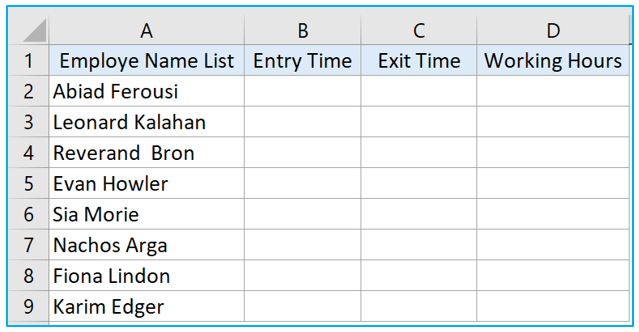
Step 1: Select cell D2 and insert this subtraction formula inside the cell. Press ENTER key and drag the fill handle downwards to apply this formula to the other cells of column D.
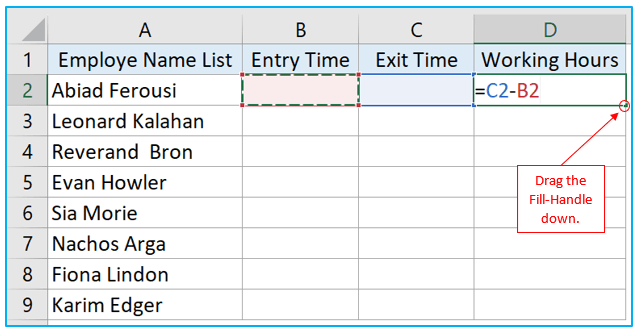
Step 2: When you drag the fill-handle down you will get this input. Make sure to format the cells of column B, C, D to Time from the Number section in the ribbons.
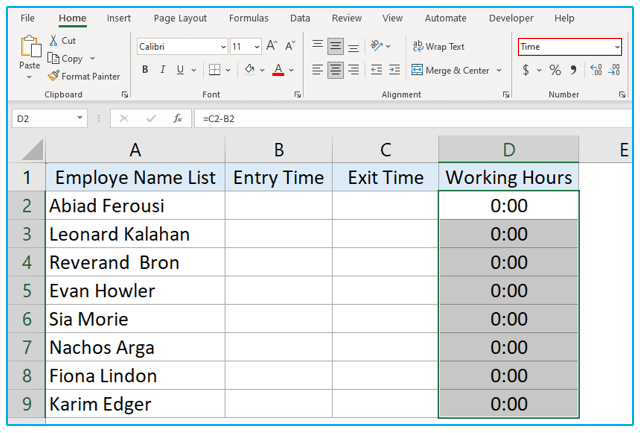
Step 3: The timesheet calculator is ready; now just enter the entry and exit time and you will get the working hours for each employe.
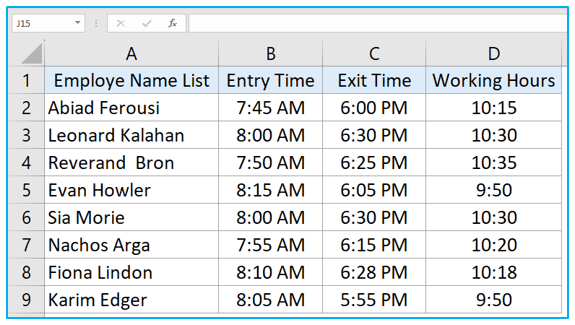
3.2 Using MOD Function without Excluding Break Time
You can use the MOD function also to get working hours without counting break time.
Step 1: Insert this MOD formula inside cell D2>>press Enter>>drag the fill-handle down.
=MOD(C2-B2,1)
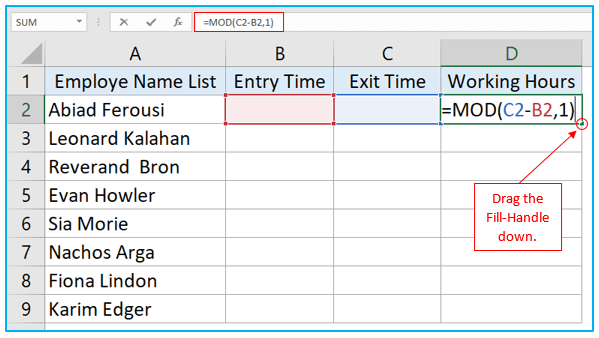
Step 2: Enter Entry and Exit time to get the result.
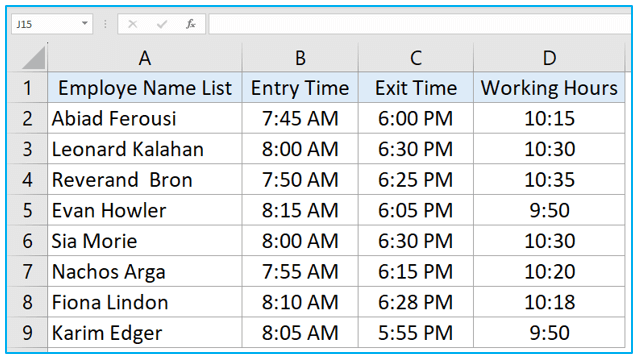
3.3 MOD Function Excluding Break Time
Now we will make a timesheet calculator considering the break time also to give it a bit more professionalism.
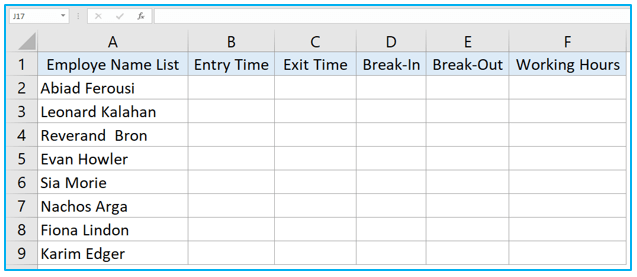
Step 1: Insert this MOD formula inside F2 and press Enter.
=MOD(C2-B2,1)-MOD(E2-D2,1)
Or,
If you don’t want to use the MOD function, you can use this other simple formula.
=(C2-B2)-(E2-D2)
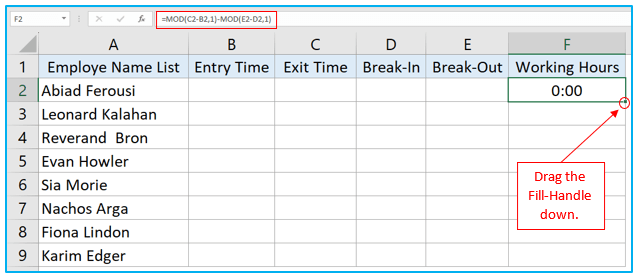
Step 2: Drag the fill-handle down to insert the formula in other cells of column F.
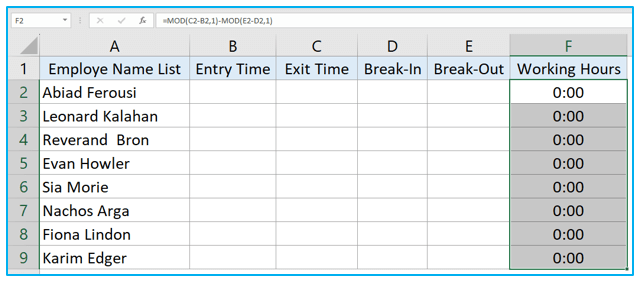
Step 3: The timesheet calculator is ready. Now enter the entry, exit, break in and out time to get the result.
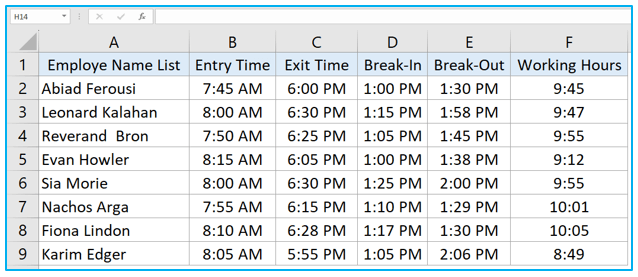
4. How to Create a Professional Timesheet Calculator?
Till now we have basically seen how a timesheet calculator works and how the calculation is done inside the timesheet. Now we will learn how we can make a professional timesheet calculator which will calculate an employee’s total weekly payment based on his working hours and extra time. Suppose the standard working hours for this company are 8 hours and the payment for this working hour is $300. And for overtime, the payment is $420. Now follow the steps below to create a professional timesheet calculator.
Step 1: Select cell A11 and insert the below given formula inside it. Press Enter key. The hours are 8 hours, 0 minutes, and 0 seconds since the TIME function was used to do this calculation. Anything above this will be regarded as overtime.
=TIME(8,0,0)
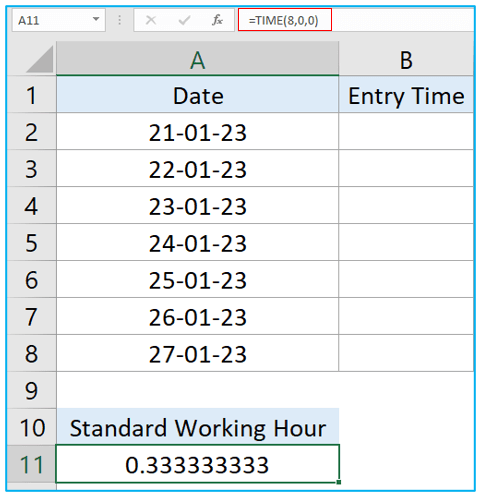
Step 2: The cell in formatted as so it isn’t showing the data correctly. To change the format, select this cell and press CTRL+1 keys to open Format Cells dialogue box. Then go to Custom tab and select “h:mm” format to show hours and minutes then press OK. Now select column F, G and H and change their format to “h:mm” in the same way too so that you don’t have to change them later.
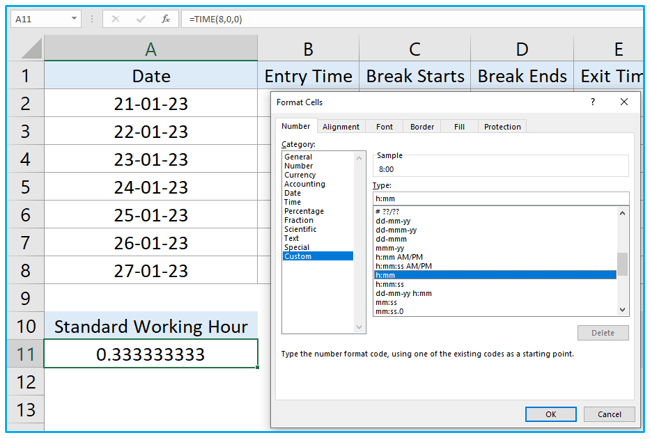
Step 3: Select cell F2 and insert this formula inside the cell to calculate the working hours for this employee.
=(C2-B2)+(E2-D2)
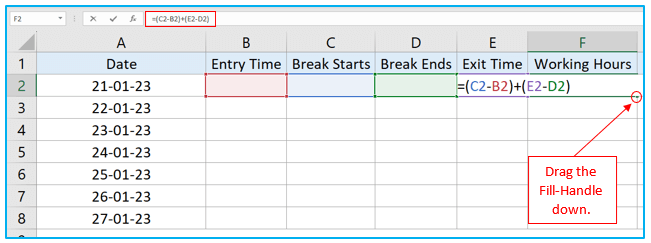
Step 4: Now drag the fill-handle down to insert the formula in other cells of this column.
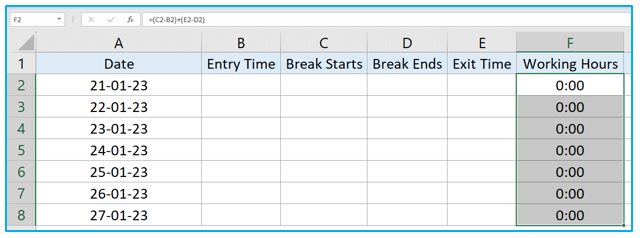
Step 5: To determine the regular working hours use the following formula in cell G2 and press Enter. Then drag it down to G8. The regular working hours are 8 hours per day but what if the worker works more than this time limit? In such cases it should display the total working hours, if not the regular eight hours.
=IF(F2>$A$11,F2,$A$11)
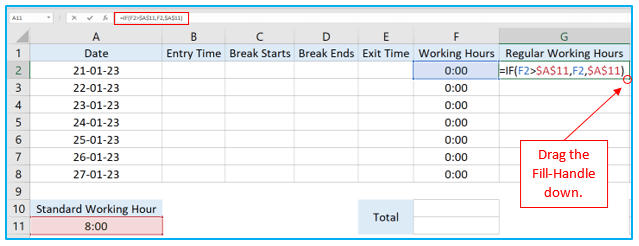
Step 6: To calculate the overtime, incorporate this formula in cell H2 and drag it down to H8. This formula will count the overtime or extra time done by this employee.
=IF(F2>$A$11,(F2-$A$11),0)
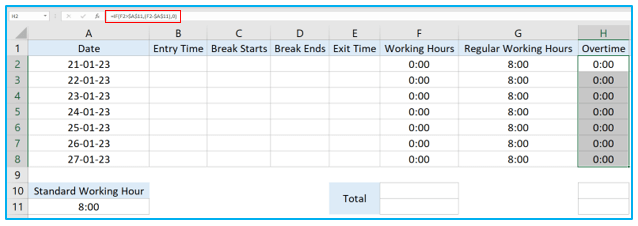
Step 7: Now calculate the total working hours using the SUM function in cell F10.
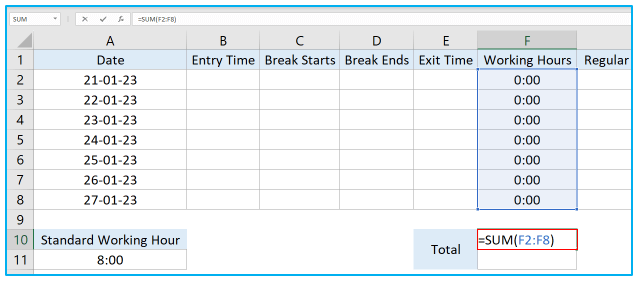
Step 8: Calculate total overtime using the same formula in H10.
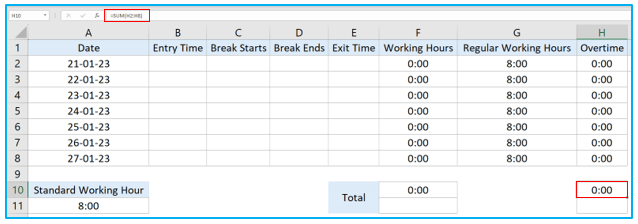
Step 9: The data in F10 and H10 are in time format. To change it to number format to calculate the payment, write the below formula in cell F11. Then repeat this in cell H11 too.
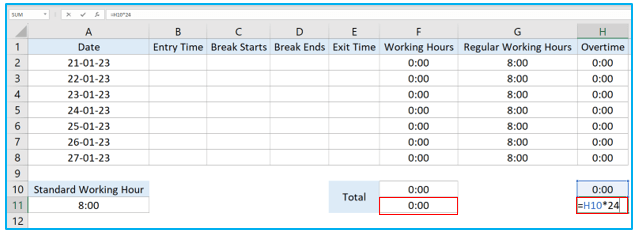
Step 10: Now select cell F11 and H11 and press CTRL+1 key to open Format Cells dialogue box. Click on Number and change the format to number format.
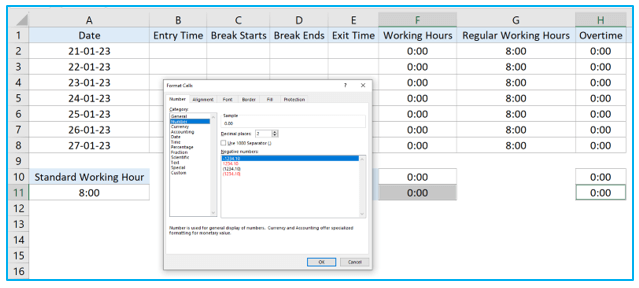
Step 11: To calculate payment, type this formula inside cell I2 and press Enter.
=F11*300+H11*420

Step 12: The calculator is ready for utilization. Now simply input the entry, exit, and break times inside the timesheet to see the result.

Application of Timesheet Calculator in Excel
- Time tracking: The Timesheet Calculator in Excel allows users to accurately record and track the hours worked by employees on a daily, weekly, or monthly basis.
- Overtime calculation: It automatically calculates overtime hours based on predefined thresholds and calculates corresponding pay rates accordingly.
- Break deduction: Users can deduct break times from total work hours to ensure accurate calculation of billable hours or productive time.
- Payroll management: Excel’s Timesheet Calculator facilitates payroll processing by providing detailed breakdowns of hours worked, overtime, and total wages owed to employees.
- Project management: It helps project managers monitor resource utilization and track labor costs by accurately recording and analyzing employee time spent on various tasks or projects.
- Compliance reporting: The Timesheet Calculator assists in compliance with labor laws and regulations by generating accurate reports of employee work hours for auditing purposes.
For ready-to-use Dashboard Templates:
